I am entertaining the idea of getting a Celestron EdgeHD 9.25 with 0.7x Reducer along with a PrimaLuce Esatto 2". I understand that the Esatto goes after the reducer and you add spacers to reach the 146mm needed (77mm after the Esatto itself). I know that the main scope is focused, the mirrors are locked, and then the Esatto is used to reach focus. However, I'm a little confused about how focus drift changes the image quality since the total back-focus would change through the night.
If someone could explain how this actually works that would help me out a lot.
|
You cannot like this item. Reason: "ANONYMOUS".
You cannot remove your like from this item.
Editing a post is only allowed within 24 hours after creating it.
You cannot Like this post because the topic is closed.
Copy the URL below to share a direct link to this post.
This post cannot be edited using the classic forums editor.
To edit this post, please enable the "New forums experience" in your settings.
I started from such combination long time ago. Essato was problem. Bad software, all sorts of other problems. I rid of it and got Moonlite dedicated focuser with motor. Cost a little bit lesser. This combination served me very well. Focuser indeed goes after reducer. When we are focusing, focal distance is changed little bit, but it is not enough for distorting of images.
Now days, I am contemplating to upgrade and get bigger scope 14+”. So I am selling entire package, if you are interested. Let me know.
All the best!
Clear skies!
Armen
|
You cannot like this item. Reason: "ANONYMOUS".
You cannot remove your like from this item.
Editing a post is only allowed within 24 hours after creating it.
You cannot Like this post because the topic is closed.
Copy the URL below to share a direct link to this post.
This post cannot be edited using the classic forums editor.
To edit this post, please enable the "New forums experience" in your settings.
Shouldn’t the focuser be between the OTA and the reducer? I thought the critical BF distance is between the reducer and the sensor.
Cheers,
Scott
|
You cannot like this item. Reason: "ANONYMOUS".
You cannot remove your like from this item.
Editing a post is only allowed within 24 hours after creating it.
You cannot Like this post because the topic is closed.
Copy the URL below to share a direct link to this post.
This post cannot be edited using the classic forums editor.
To edit this post, please enable the "New forums experience" in your settings.
Great question! I haven't noticed any degradation in image quality doing this. I'd like to hear any other experiences and/or technical discussion. I have a Celestron EdgeHD 9.25 with 0.7x reducer connected to a MoonLite Litecrawler focuser/rotator. My startup routine is usually to extend the focuser to 5mm which achieves 146.3 mm backfocus and puts the focuser mid-range. The .3 is to compensate for the Chroma filters. Then I focus the primary with a Celestron auto focuser. I lock the mirror at this point for the night and start imaging. This at least initially sets the image train to spec. 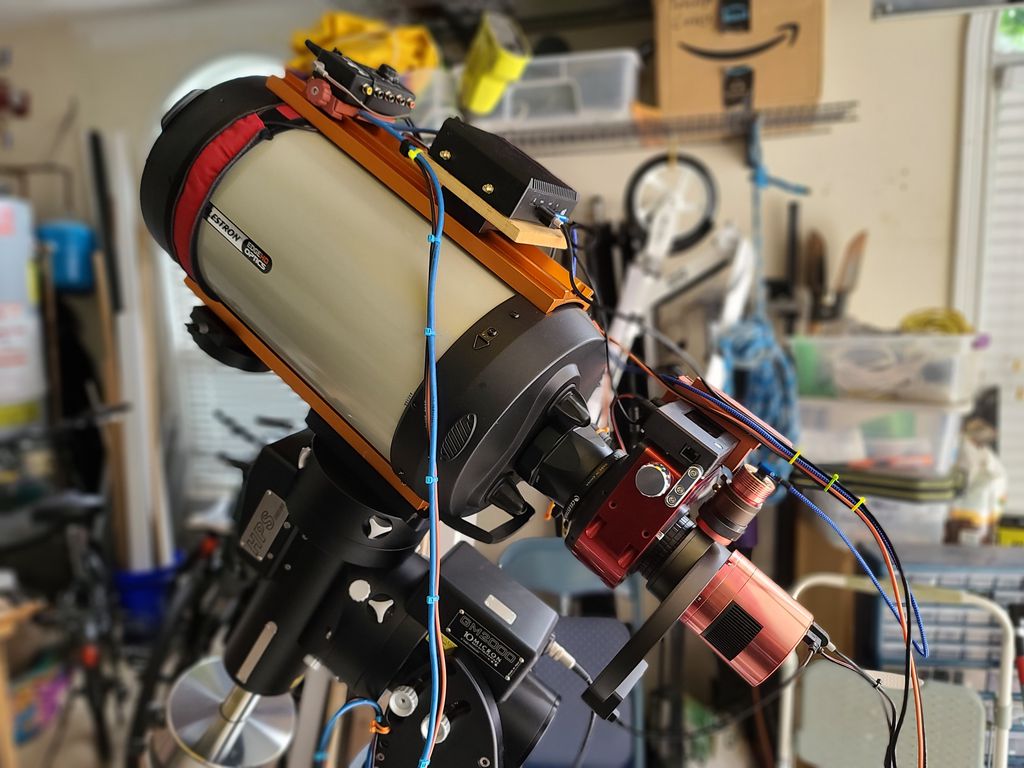 |
You cannot like this item. Reason: "ANONYMOUS".
You cannot remove your like from this item.
Editing a post is only allowed within 24 hours after creating it.
You cannot Like this post because the topic is closed.
Copy the URL below to share a direct link to this post.
This post cannot be edited using the classic forums editor.
To edit this post, please enable the "New forums experience" in your settings.
Scott Badger:
Shouldn’t the focuser be between the OTA and the reducer? I thought the critical BF distance is between the reducer and the sensor.
Cheers,
Scott Yes this is what I thought too, but PrimaLuce advertises it as going after the reducer.
|
You cannot like this item. Reason: "ANONYMOUS".
You cannot remove your like from this item.
Editing a post is only allowed within 24 hours after creating it.
You cannot Like this post because the topic is closed.
Copy the URL below to share a direct link to this post.
This post cannot be edited using the classic forums editor.
To edit this post, please enable the "New forums experience" in your settings.
Joshua Carter:
Scott Badger:
Shouldn’t the focuser be between the OTA and the reducer? I thought the critical BF distance is between the reducer and the sensor.
Cheers,
Scott
Yes this is what I thought too, but PrimaLuce advertises it as going after the reducer. No, at the end for Moonlite and Essato.
|
You cannot like this item. Reason: "ANONYMOUS".
You cannot remove your like from this item.
Editing a post is only allowed within 24 hours after creating it.
You cannot Like this post because the topic is closed.
Copy the URL below to share a direct link to this post.
This post cannot be edited using the classic forums editor.
To edit this post, please enable the "New forums experience" in your settings.
Phil Montgomery:
Great question! I haven't noticed any degradation in image quality doing this. I'd like to hear any other experiences and/or technical discussion.
I have a Celestron EdgeHD 9.25 with 0.7x reducer connected to a MoonLite Litecrawler focuser/rotator. My startup routine is usually to extend the focuser to 5mm which achieves 146.3 mm backfocus and puts the focuser mid-range. The .3 is to compensate for the Chroma filters. Then I focus the primary with a Celestron auto focuser. I lock the mirror at this point for the night and start imaging. This at least initially sets the image train to spec. I guess there's no way to get around having to touch the main focuser? I wanted to have this as a remote rig where the mirror would remain locked and just use the esatto to focus. I guess it doesn't work that way.
|
You cannot like this item. Reason: "ANONYMOUS".
You cannot remove your like from this item.
Editing a post is only allowed within 24 hours after creating it.
You cannot Like this post because the topic is closed.
Copy the URL below to share a direct link to this post.
This post cannot be edited using the classic forums editor.
To edit this post, please enable the "New forums experience" in your settings.
Joshua Carter:
Phil Montgomery:
Great question! I haven't noticed any degradation in image quality doing this. I'd like to hear any other experiences and/or technical discussion.
I have a Celestron EdgeHD 9.25 with 0.7x reducer connected to a MoonLite Litecrawler focuser/rotator. My startup routine is usually to extend the focuser to 5mm which achieves 146.3 mm backfocus and puts the focuser mid-range. The .3 is to compensate for the Chroma filters. Then I focus the primary with a Celestron auto focuser. I lock the mirror at this point for the night and start imaging. This at least initially sets the image train to spec.
I guess there's no way to get around having to touch the main focuser? I wanted to have this as a remote rig where the mirror would remain locked and just use the esatto to focus. I guess it doesn't work that way. I used this system as remote rig in NM.
|
You cannot like this item. Reason: "ANONYMOUS".
You cannot remove your like from this item.
Editing a post is only allowed within 24 hours after creating it.
You cannot Like this post because the topic is closed.
Copy the URL below to share a direct link to this post.
This post cannot be edited using the classic forums editor.
To edit this post, please enable the "New forums experience" in your settings.
The Esatto is placed after the reducer with added spacers to reach 146.3mm to the sensor plane.
The initial focus is done with the focus knob and after that the Esatto only compensates in microns to adjust for temperature.
You could ask the question for what temperature does the 146.3mm backfocus apply.
|
You cannot like this item. Reason: "ANONYMOUS".
You cannot remove your like from this item.
Editing a post is only allowed within 24 hours after creating it.
You cannot Like this post because the topic is closed.
Copy the URL below to share a direct link to this post.
This post cannot be edited using the classic forums editor.
To edit this post, please enable the "New forums experience" in your settings.
AnaTa:
Joshua Carter:
Phil Montgomery:
Great question! I haven't noticed any degradation in image quality doing this. I'd like to hear any other experiences and/or technical discussion.
I have a Celestron EdgeHD 9.25 with 0.7x reducer connected to a MoonLite Litecrawler focuser/rotator. My startup routine is usually to extend the focuser to 5mm which achieves 146.3 mm backfocus and puts the focuser mid-range. The .3 is to compensate for the Chroma filters. Then I focus the primary with a Celestron auto focuser. I lock the mirror at this point for the night and start imaging. This at least initially sets the image train to spec.
I guess there's no way to get around having to touch the main focuser? I wanted to have this as a remote rig where the mirror would remain locked and just use the esatto to focus. I guess it doesn't work that way.
I used this system as remote rig in NM.
It probably doesn't require refocusing the primary every time. I just assumed it was required. I'll try testing that. |
You cannot like this item. Reason: "ANONYMOUS".
You cannot remove your like from this item.
Editing a post is only allowed within 24 hours after creating it.
You cannot Like this post because the topic is closed.
Copy the URL below to share a direct link to this post.
This post cannot be edited using the classic forums editor.
To edit this post, please enable the "New forums experience" in your settings.
I use this exact setup. I will post a proper reply later today with more details. Spoiler alert - it has worked perfectly for me.
ML
|
You cannot like this item. Reason: "ANONYMOUS".
You cannot remove your like from this item.
Editing a post is only allowed within 24 hours after creating it.
You cannot Like this post because the topic is closed.
Copy the URL below to share a direct link to this post.
This post cannot be edited using the classic forums editor.
To edit this post, please enable the "New forums experience" in your settings.
Hi Josh I am not an expert but I had first light for Celestron EdgeHD9.25, ASI2600MM and 0.7 Reducer a couple of nights ago and this is a sub from the first night of imaging with the Ha filter, 600 Sec and stars are pretty good all the way to the edge. I use the Feathertouch Focuser and that works really well with or without the reducer and my mirrors are locked down all the time. 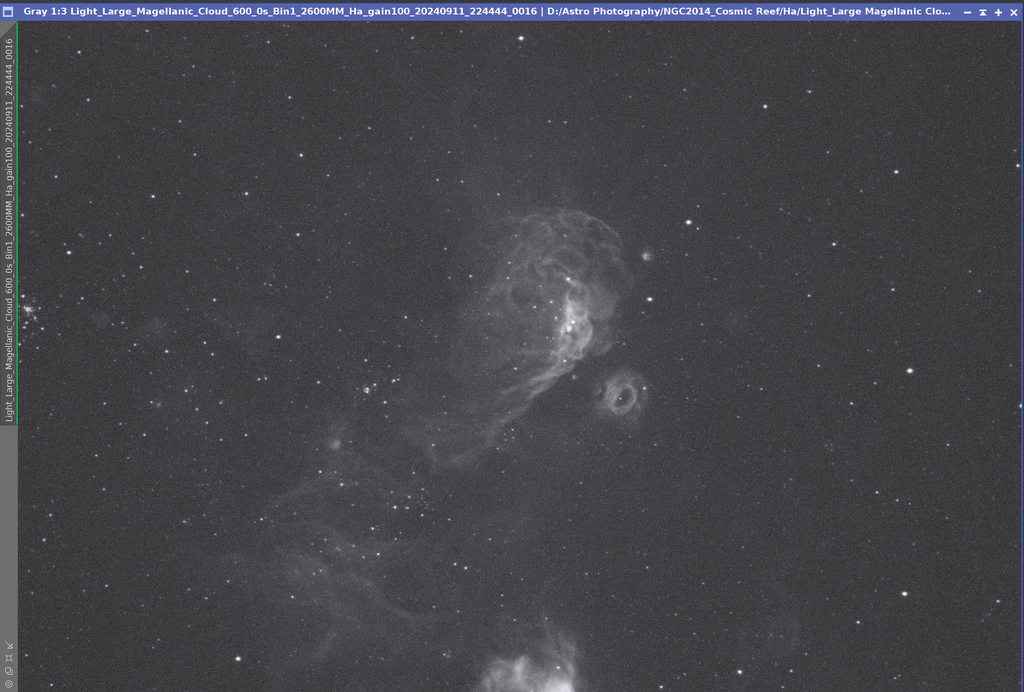 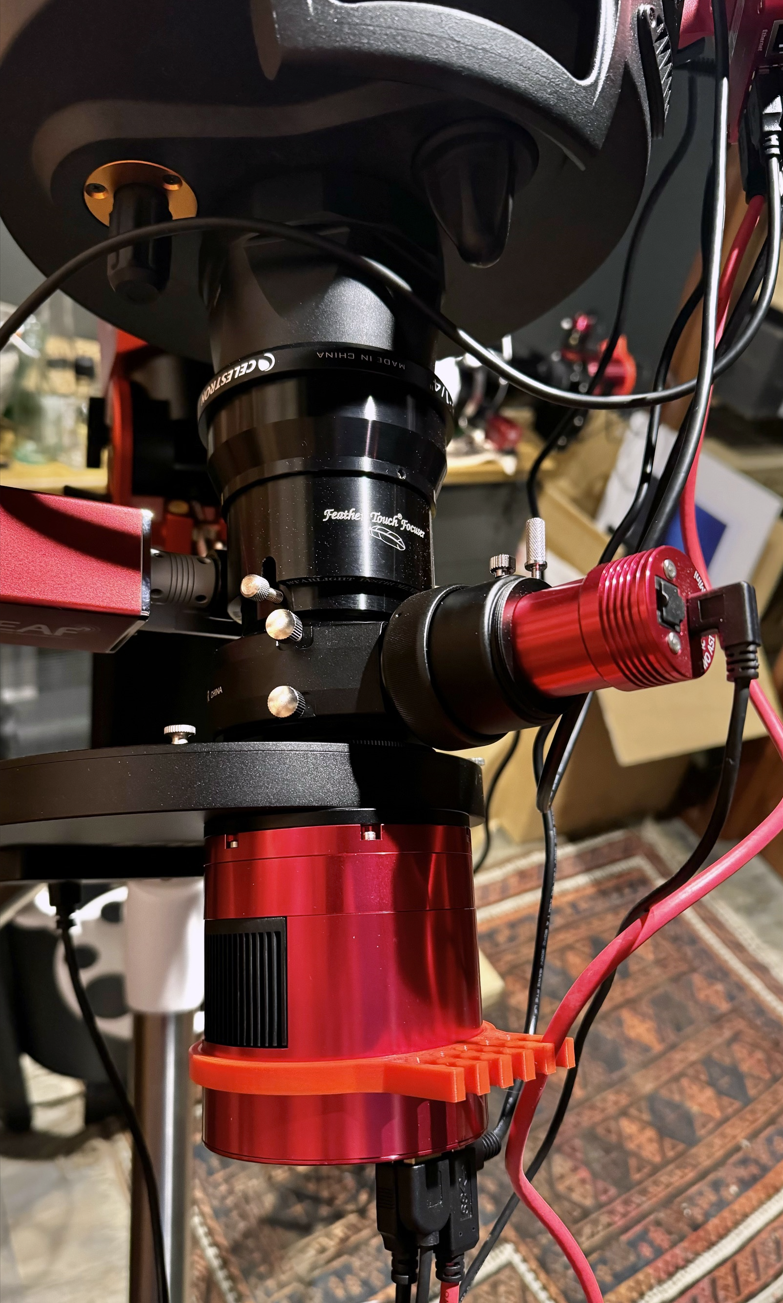 For backfocus, I worked it out to be around 146.71 (including allowance of 0.66 for filter) and the "Shorty" takes care of that easily with the EAF routine. Hope that help a little Peter
|
You cannot like this item. Reason: "ANONYMOUS".
You cannot remove your like from this item.
Editing a post is only allowed within 24 hours after creating it.
You cannot Like this post because the topic is closed.
Copy the URL below to share a direct link to this post.
This post cannot be edited using the classic forums editor.
To edit this post, please enable the "New forums experience" in your settings.
How thick are your filters for adding .66 bf?
|
You cannot like this item. Reason: "ANONYMOUS".
You cannot remove your like from this item.
Editing a post is only allowed within 24 hours after creating it.
You cannot Like this post because the topic is closed.
Copy the URL below to share a direct link to this post.
This post cannot be edited using the classic forums editor.
To edit this post, please enable the "New forums experience" in your settings.
Phil…..The Antlia 2.5nm filters are around 2mm thick.
|
You cannot like this item. Reason: "ANONYMOUS".
You cannot remove your like from this item.
Editing a post is only allowed within 24 hours after creating it.
You cannot Like this post because the topic is closed.
Copy the URL below to share a direct link to this post.
This post cannot be edited using the classic forums editor.
To edit this post, please enable the "New forums experience" in your settings.
OK, so to add to my post above: My current setup: - Edge 9.25HD OTA
- Celestron 0.7x reducer
- Esatto 2" Focuser with appropriate adapters
- Celestron OAG
- Celestron M48 to M42 Adapter
- ASI1600
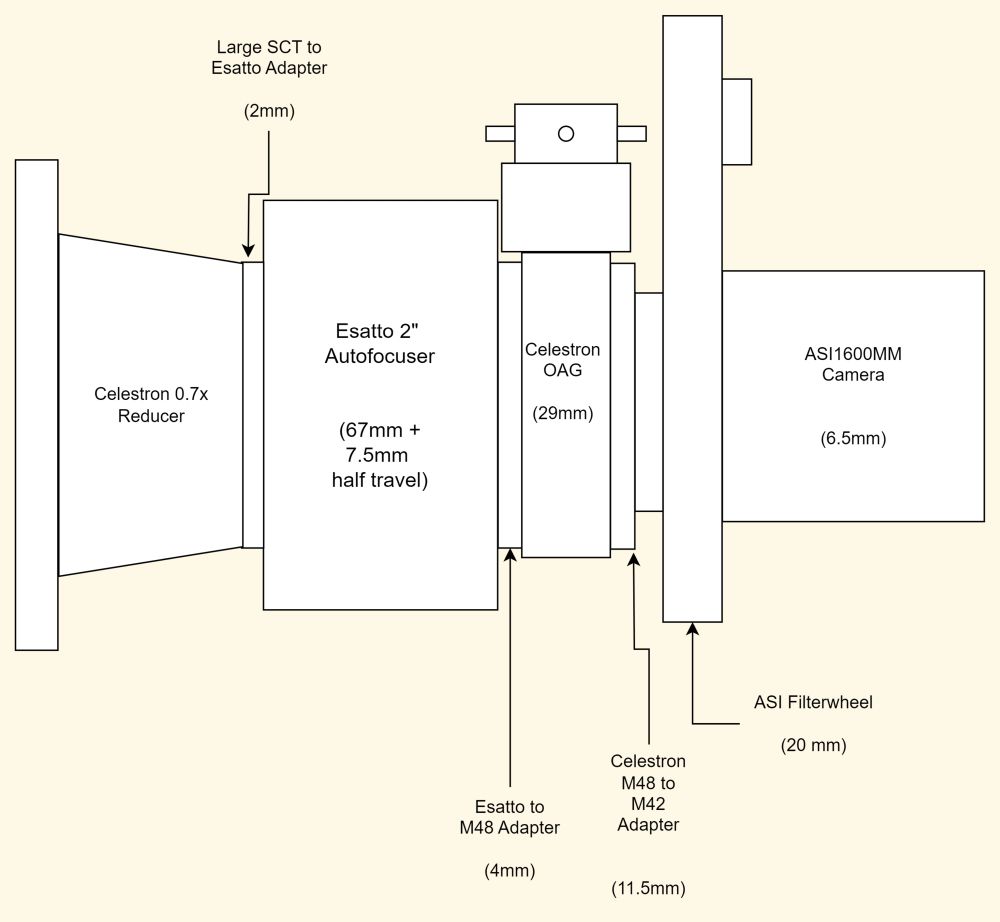 I have not had a lot of chance to image since the OAG was added, but here is an example image with the OAG in the image train:  ============================================================================================================================= My previous setup: - Edge 9.25HD OTA
- Celestron 0.7x reducer
- Esatto 2" Focuser with appropriate adapters
- 30mm M48 spacer
- M48 to M42 adapter
, but here is an example with this setup: 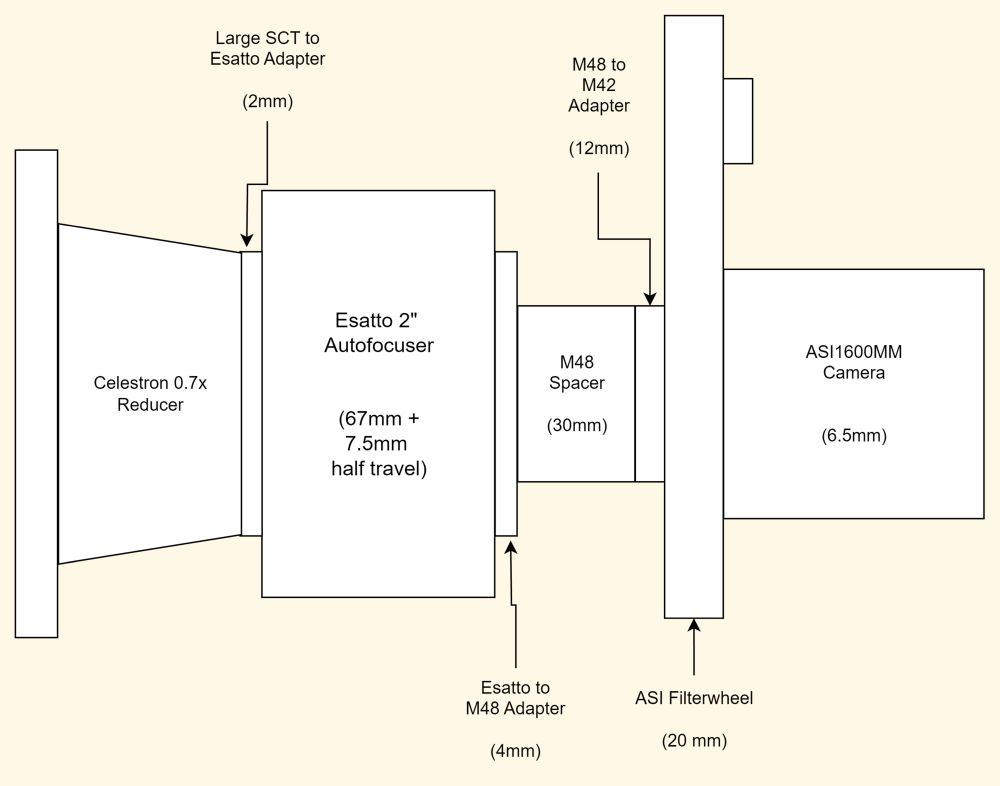 In both cases, I have gotten great results. Of course, this is with the 1600 sensor, which is only a 4/3rds size, so that may help. Here is an example with the previous setup:  It is of course always nice to try to hit the backspacing exactly if you can. But that being said, it is maybe not as critical as a lot of folks would have you believe. Here is a technical article from Dr. Gaston Baudat, the founder and brains behind Innovations Foresight, the guys who make the ONAG (On Axis Guider). He went through the theory including the effects of seeing compared to the impact of imperfect EdgeHD backspacing. The conclusion that I got from it is you don't have to sweat every single millimeter of difference between the theoretical exact spacing and what you end up with... See what you think after reading the article... https://www.innovationsforesight.com/support/celestron-edgehd-back-focus-tolerance/ML
|
You cannot like this item. Reason: "ANONYMOUS".
You cannot remove your like from this item.
Editing a post is only allowed within 24 hours after creating it.
You cannot Like this post because the topic is closed.
Copy the URL below to share a direct link to this post.
This post cannot be edited using the classic forums editor.
To edit this post, please enable the "New forums experience" in your settings.
Phil Montgomery:
Great question! I haven't noticed any degradation in image quality doing this. I'd like to hear any other experiences and/or technical discussion.
I have a Celestron EdgeHD 9.25 with 0.7x reducer connected to a MoonLite Litecrawler focuser/rotator. My startup routine is usually to extend the focuser to 5mm which achieves 146.3 mm backfocus and puts the focuser mid-range. The .3 is to compensate for the Chroma filters. Then I focus the primary with a Celestron auto focuser. I lock the mirror at this point for the night and start imaging. This at least initially sets the image train to spec.
 Great set up. Exactly like mine 😀. Why do you need OAG with your mount?
|
You cannot like this item. Reason: "ANONYMOUS".
You cannot remove your like from this item.
Editing a post is only allowed within 24 hours after creating it.
You cannot Like this post because the topic is closed.
Copy the URL below to share a direct link to this post.
This post cannot be edited using the classic forums editor.
To edit this post, please enable the "New forums experience" in your settings.
Thanks! Although the 10Micron performs very good without guiding, there are times when I get slightly better performance with the OAG.
|
You cannot like this item. Reason: "ANONYMOUS".
You cannot remove your like from this item.
Editing a post is only allowed within 24 hours after creating it.
You cannot Like this post because the topic is closed.
Copy the URL below to share a direct link to this post.
This post cannot be edited using the classic forums editor.
To edit this post, please enable the "New forums experience" in your settings.
I would echo what Phil says. My MyT works very well, but I get slightly better guiding with the OAG. In my case I think it is maybe some differential flexure issues that I had with my external guiding setup that are removed when using the OAG.
ML
|
You cannot like this item. Reason: "ANONYMOUS".
You cannot remove your like from this item.
Editing a post is only allowed within 24 hours after creating it.
You cannot Like this post because the topic is closed.
Copy the URL below to share a direct link to this post.
This post cannot be edited using the classic forums editor.
To edit this post, please enable the "New forums experience" in your settings.
Phil Montgomery:
Thanks! Although the 10Micron performs very good without guiding, there are times when I get slightly better performance with the OAG. Interesting, it is other way around for me. Guiding was unproductive, I stopped it. Generally, only reason I got it is to stop guiding. Never liked it 🤨
|
You cannot like this item. Reason: "ANONYMOUS".
You cannot remove your like from this item.
Editing a post is only allowed within 24 hours after creating it.
You cannot Like this post because the topic is closed.
Copy the URL below to share a direct link to this post.
This post cannot be edited using the classic forums editor.
To edit this post, please enable the "New forums experience" in your settings.
I would echo what Phil says. My MyT works very well, but I get slightly better guiding with the OAG. In my case I think it is maybe some differential flexure issues that I had with my external guiding setup that are removed when using the OAG.
ML MyT doesn’t have encoders, it is understandable. This has encoders, then what is point to spend 4-5K only for encoders.
|
You cannot like this item. Reason: "ANONYMOUS".
You cannot remove your like from this item.
Editing a post is only allowed within 24 hours after creating it.
You cannot Like this post because the topic is closed.
Copy the URL below to share a direct link to this post.
This post cannot be edited using the classic forums editor.
To edit this post, please enable the "New forums experience" in your settings.
AnaTa:
I would echo what Phil says. My MyT works very well, but I get slightly better guiding with the OAG. In my case I think it is maybe some differential flexure issues that I had with my external guiding setup that are removed when using the OAG.
ML
MyT doesn’t have encoders, it is understandable. This has encoders, then what is point to spend 4-5K only for encoders.
That is a fair point. Yes, having encoders should make a difference one would think, assuming that the polar alignment has been done well. If The system is being setup each night instead of being used in a permanent setup I could still see a situation where you might use an OAG even with encoders. It is also possible that the imaging setup might also be used on different mounts too. hard to know all the details from a short post I would say.
ML |
You cannot like this item. Reason: "ANONYMOUS".
You cannot remove your like from this item.
Editing a post is only allowed within 24 hours after creating it.
You cannot Like this post because the topic is closed.
Copy the URL below to share a direct link to this post.
This post cannot be edited using the classic forums editor.
To edit this post, please enable the "New forums experience" in your settings.
AnaTa:
I would echo what Phil says. My MyT works very well, but I get slightly better guiding with the OAG. In my case I think it is maybe some differential flexure issues that I had with my external guiding setup that are removed when using the OAG.
ML
MyT doesn’t have encoders, it is understandable. This has encoders, then what is point to spend 4-5K only for encoders.
That is a fair point. Yes, having encoders should make a difference one would think, assuming that the polar alignment has been done well. If The system is being setup each night instead of being used in a permanent setup I could still see a situation where you might use an OAG even with encoders. It is also possible that the imaging setup might also be used on different mounts too. hard to know all the details from a short post I would say.
ML
Polar alignment routine for 10 micron is super accurate. However, my experience showed that it is not as critical as building meticulously sky model. I manage to get under 7” for 9.25” Edge. Don’t guide even at F10 with 10 min subs. CS! Armen
|
You cannot like this item. Reason: "ANONYMOUS".
You cannot remove your like from this item.
Editing a post is only allowed within 24 hours after creating it.
You cannot Like this post because the topic is closed.
Copy the URL below to share a direct link to this post.
This post cannot be edited using the classic forums editor.
To edit this post, please enable the "New forums experience" in your settings.
Yes, I use TPoint for sky modeling on the MyT and have perfect pointing and very good guiding as well, but as stated above, had some issues with differential flexure so I went to OAG. I frequently guide below 0.6 arcsec RMS with this setup on the Edge with the reducer inline. I have not yet imaged with the scope at native focal length, will have to try that at some point.
My gear is located at a friend's house in southern Arizona and remotely controlled from where I live here in Colorado. It is ~15 hour drive to get down there so gear changes are not something that I can do all the time.
ML
|
You cannot like this item. Reason: "ANONYMOUS".
You cannot remove your like from this item.
Editing a post is only allowed within 24 hours after creating it.
You cannot Like this post because the topic is closed.
Copy the URL below to share a direct link to this post.
This post cannot be edited using the classic forums editor.
To edit this post, please enable the "New forums experience" in your settings.
Hi Joshua,
I have a similar setup, Edge11 with the 2" Esatto LP (the low profile version which eats up less of backfocus). You are correct, with such a setup you are slightly out of ideal back focus.
The SCT are quite sensitive to temperature changes as the thermal contraction of the tube is amplified by a factor of 25 (square of the 5x magnification owing to the concave secondary).
so for a middle European typical night with a temperature drop of some 5C I find a change in focus position of some 0.6mm. So at the beginning of the night I focus with the Esatto some 0.3mm too short (ie half way the anticipated temperature drop), and focus by hand with the standard Celestron focuser + Bathinov mask. Then I do the observing run, and typically end the night some 0.3mm too long in BF. For these type of deviations, no real deterioration of the image quality is visible (full format sensor). This may change in a desert climate with temperature changes of >10C over night. Gaston Baudat of innovationforesight has made an estimate that for typical seeing even a few mm error in BF should not matter, however these estimates are probably too optimistic: he assumes circular stars, but with bad BF you get image distortions which are much easier to see.
overall I see the external focuser as a "nice to have" but not essential piece of equipment. With the standard focuser and an EAF one can cope quite well, make sure that the last focuser motion is always counter clock wise, so you push the mirror. She main benefit of the external focuser is that you get rid of annoying image shift (and resulting problems with guiding when using an OAG) when you change filters.
Matthias
|
You cannot like this item. Reason: "ANONYMOUS".
You cannot remove your like from this item.
Editing a post is only allowed within 24 hours after creating it.
You cannot Like this post because the topic is closed.
Copy the URL below to share a direct link to this post.
This post cannot be edited using the classic forums editor.
To edit this post, please enable the "New forums experience" in your settings.
Yes, I use TPoint for sky modeling on the MyT and have perfect pointing and very good guiding as well, but as stated above, had some issues with differential flexure so I went to OAG. I frequently guide below 0.6 arcsec RMS with this setup on the Edge with the reducer inline. I have not yet imaged with the scope at native focal length, will have to try that at some point.
My gear is located at a friend's house in southern Arizona and remotely controlled from where I live here in Colorado. It is ~15 hour drive to get down there so gear changes are not something that I can do all the time.
ML I think differential flexture for SCT is due to moving mirror. I tightened it slightly. Moved scope for 2-3 h, tighten it again moved it 2-3h and tighten final time with maximum force. This is a way, I set it in a NM remote observatory. 10 micron modeling accuracy is ultimate indicator of differential flexture. I started from whooping 25”, finally got to 7” with Edge. Champion is still Epsilon 130D with only 3” RMS after modeling. Clear Skies!
|
You cannot like this item. Reason: "ANONYMOUS".
You cannot remove your like from this item.
Editing a post is only allowed within 24 hours after creating it.
You cannot Like this post because the topic is closed.
Copy the URL below to share a direct link to this post.
This post cannot be edited using the classic forums editor.
To edit this post, please enable the "New forums experience" in your settings.









